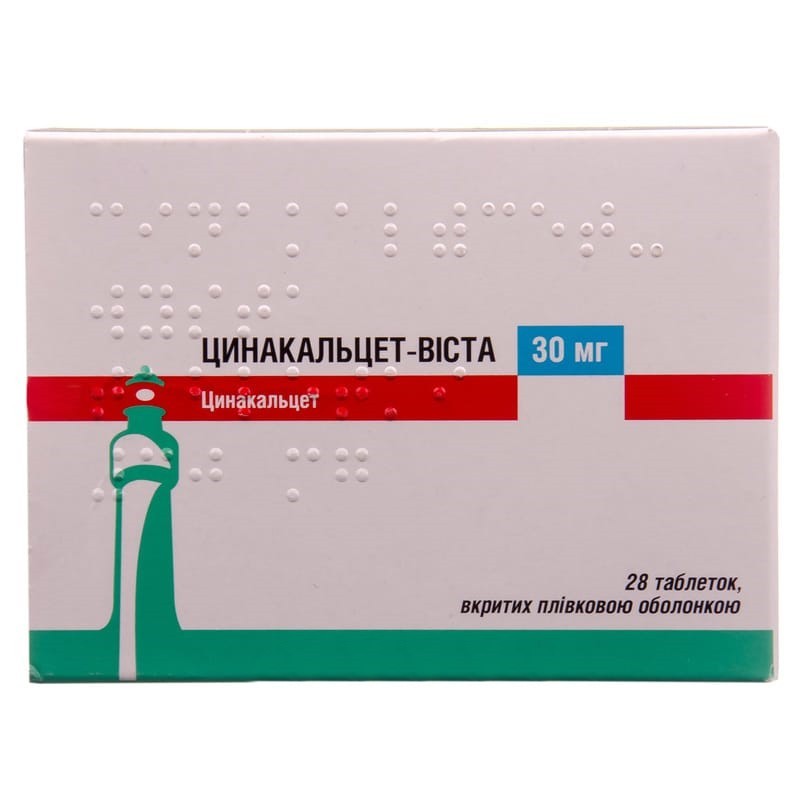



 Secure and encrypted payment processing
Secure and encrypted payment processing We ship to over 40 countries including the USA, UK, Europe, Australia and Japan
We ship to over 40 countries including the USA, UK, Europe, Australia and Japan Guaranteed refund or reship if you haven't received your order
Guaranteed refund or reship if you haven't received your orderCinacalcet-Vista will provide treatment for secondary hyperparathyroidism in patients with end-stage kidney disease who are on maintenance hemodialysis.
Active ingredient: cinnacalcet, 1 coated tablet contains 30 mg of cinacalcet, which is equivalent to 33.06 mg of cinacalcet hydrochloride.
Excipients: corn starch, crospovidone, povidone, microcrystalline cellulose, colloidal silicon dioxide, magnesium stearate.
Shell: polyvinyl alcohol partially hydrolyzed, titanium dioxide (E 171), macrogol, talc, indigo aluminum varnish, iron oxide yellow (E 172).
Hypersensitivity to the active substance or to any of the excipients indicated in the composition section.
The recommended starting dose for adults is 30 mg once daily.
Titration of the dose of cynacalcet should be carried out every 2-4 weeks until the maximum dose of 180 mg is reached once a day, at which the required concentration of parathyroid hormone (PTH) in the range of 150-300 pg / ml is achieved in patients on hemodialysis (15 9- 31.8 pmol / L), which is determined by the content of intact PTH (test for the content of PTH).
Determination of the concentration of PTH should be carried out no earlier than 12 hours after taking cinnacalcet.
Determination of the concentration of PTH should be carried out 1-4 weeks after the start of therapy or dose adjustment of cinacalcet. To determine the concentration of PTH, the content of IPTG or bio-contact PTH (bPTH) can be monitored. Treatment with cynacalcet does not alter the relationship between IPTG and biPTG.
There are no clinical data on the use of cinnacalcet in pregnant women.
Animal studies do not show direct harmful effects on pregnancy, childbirth and postpartum development.
No embryonic and fetal toxicity has been reported in studies of pregnant animals, with the exception of a decrease in fetal body weight at doses associated with maternal toxicity.
Therefore, cinacalcet can be used during pregnancy only when the expected benefit outweighs the potential risk to the fetus.
Some adverse reactions may affect your ability to drive and operate machinery.
Cinacalceta is not intended for use by children and adolescents due to the lack of data on safety and effectiveness.
Titrated doses of up to 300 mg once daily were safely used in patients on dialysis.
An overdose of cynacalcet can lead to hypocalcemia.
In case of overdose, patients should be checked for symptoms of hypocalcemia, and treatment should be symptomatic and supportive.
Since cinacalceta is very easily bound to proteins, hemodialysis is not an effective treatment for overdose.
Based on the available results of a placebo-controlled study involving patients treated with cynacalcet, the most common side effects were nausea and vomiting, which were mild to moderate and, in most cases, were short-lived. Discontinuation of therapy due to the development of adverse reactions was caused mainly by nausea and vomiting.
Also occur:
hypersensitivity reactions, anorexia, decreased appetite, convulsions, dizziness, paresthesia, worsening heart failure, prolongation of the QT interval and ventricular arrhythmia against hypocalcemia, upper respiratory tract infection, shortness of breath, cough, shortness of breath, hypotension, nausea, vomiting, dyspepsia, diarrhea in the abdomen, pain in the upper abdomen, constipation, rash, myalgia, muscle cramps, back pain, asthenia, hypocalcemia, hyperkalemia, decreased testosterone levels.
Hypersensitivity reactions, including angioedema and urticaria, were detected during the post-registration period of the use of cynacalcet.
The frequency of individual adverse reactions, including angioedema and urticaria, cannot be determined from the available data.
There have been reports of individual cases of hypotension and worsening heart failure in patients with impaired heart function who took cynacalcet during the post-registration observation period; Based on the available data, the frequency of such cases cannot be determined.
Prolongation of the QT interval and ventricular arrhythmia against hypocalcemia were found during the post-registration period of the use of cynacalcet, the frequency of which can be estimated based on available data.
Shelf life 3 years.
Store in at a temperature not exceeding 25 ° C.
Keep out of the reach of children.